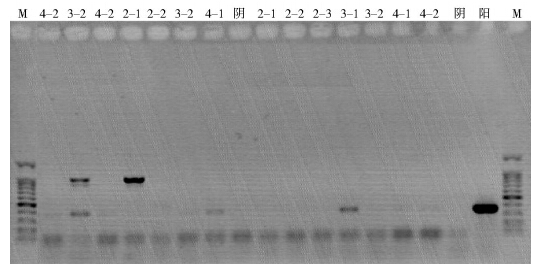扩展功能
文章信息
- 吴海霞, 李志芳, 刘起勇, 张卫东, 栗冬梅, 马怀雷, 鲁亮, 刘京利
- WU Hai-xia, LI Zhi-fang, LIU Qi-yong, ZHANG Wei-dong, LI Dong-mei, MA Huai-lei, LU Liang, LIU Jing-li
- 首次在长角血蜱中检测到汉赛巴尔通体
- First detection of Bartonella henselae infection in Haemaphysalis longicornis
- 中国媒介生物学及控制杂志, 2015, 26(1): 16-18
- Chin J Vector Biol & Control, 2015, 26(1): 16-18
- 10.11853/j.issn.1003.4692.2015.01.004
-
文章历史
- 收稿日期:2014-09-25
- 网络出版时间:2014-12-07
2. 郑州大学公共卫生学院;
3. 郑州大学附属洛阳中心医院
2. Department of Epidemiology and Health Statistics, College of Public Health, Zhengzhou University;
3. Luoyang Central Hospital Affiliated to Zhengzhou University
蜱是最重要的疾病传播媒介之一,可以传播细菌(螺旋体、立克次体和弗朗西斯氏菌等)、病毒(黄病毒、Colti病毒和内罗病毒等)和寄生虫等(巴贝西虫等)[1]。栗冬梅等[2]、孙继民等[3]、凌锋等[4]在我国微小扇头蜱(Rhipicephalus microplus)、中华硬蜱(Ixodes sinensis)和长角血蜱(Haemaphysalis longicornis)等蜱种中分离或检测到巴尔通体,并已在猫、犬、啮齿类动物中分离或检测到巴尔通体[5]。巴尔通体的人类感染近年来在我国引起关注,特别是致病的汉赛巴尔通体(Bartonella henselae)、五日热巴尔通体(Bartonella quintana)等,由汉赛巴尔通体引起的猫抓病已有多起报道。现将采自石家庄市灵寿县长角血蜱中的汉赛巴尔通体自然感染情况报道如下。 1 材料与方法 1.1 蜱样本
2010年4月在石家庄市灵寿县羊群身上采集,均为若蜱。共20只,分成7组。其中饱血若蜱6只,分为3组,编号分别为2-1、2-2、2-3;半饱血若蜱8只,分为2组,编号分别为4-1、4-2;已死亡蜱(未饱血)6只,分为2组,编号分别为3-1、3-2。 1.2 DNA提取及血培养
首先将蜱用适量碘酊浸泡5 min,然后用75%乙醇重复2次各浸泡3 min,再用灭菌蒸馏水漂洗3次,最后加500 μl无菌生理盐水用研磨棒研磨成匀浆,取出一半用于接种分离,即接种到含5%羊血的胰酶大豆培养基上,置于37 ℃含5%CO2的培养箱中培养,每份样品接种2份培养基;另一半用于提取DNA,按照QIAgen组织提取试剂盒说明书操作步骤进行。 1.3 PCR扩增
采用伯乐公司的PCR扩增仪,用汉赛巴尔通体特异引物[6],即BhCS.781p 5′-GGG GAC CAG CTC ATG GTG G-3′,BhCS.1137n 5′-AAT GCA AAA AGA ACA GTA AAC A-3′,反应体系为Master mix 12.5 μl,ddH2O 9.5 μl,上、下游引物各1 μl,模板1 μl,反应条件为95 ℃ 2 min;95 ℃ 30 s,48 ℃ 30 s,72 ℃ 30 s,共30个循环;72 ℃ 5 min。设立阴性对照和阳性对照组。 1.4 测序
电泳后将有阳性条带的PCR产物交生工生物工程(上海)股份有限公司双向测序。如有2条带则用Promega公司的试剂盒回收纯化阳性条带。 1.5 DNA比对
所测序列在NCBI(http://www.ncbi.nlm.nih.gov/BLAST)用Blast进行比对。 2 结 果 2.1 蜱类鉴定
经过形态学鉴定,采自石家庄市灵寿县的蜱类均为长角血蜱。 2.2 直接提取DNA的蜱样品PCR结果
除阳性对照外,样品3-1出现阳性条带,电泳结果见图 1。

|
| 注:M. Marker; 左侧7个编号为蜱经培养获取菌落提取的DNA样品; 右侧7个编号为蜱直接提取的DNA样品。 图 1 经培养获取菌落DNA的蜱样品和直接提取DNA的蜱样品PCR后电泳图 Figure 1 The electrophoretogram of PCR products from DNA samples of cultured B. henselae colonies and DNA samples from direct extraction |
均可见细菌生成,但不能鉴定为何种细菌。挑取疑似菌落进行PCR检测,即挑取适量菌落溶于PBS(pH 7.4)中,5204×g离心10 min。提取DNA,PCR检测除阳性对照外均阴性,见图 1。 2.4 测序和序列比对
对出现较为明显阳性条带的3个样品进行测序,菌落提取的DNA样品3-2进行琼脂凝胶DNA纯化后测序,未得出结果;菌落提取的DNA样品4-1凝胶电泳显示阳性,但测序未得结果;直接提取的DNA样品3-1经测序与汉赛巴尔通体山东猫分离株(M80SHD)、河南猫分离株(M21HN)、Bartonella henselae str. Houston-1(GenBank:BX897699.1)同源性均为100%。 3 讨 论
对血培养后的菌落进行PCR检测,检测到特异性的汉赛巴尔通体片段,与GenBank中山东省分离株gltA基因片段序列完全一致。说明石家庄市采获的长角血蜱中存在汉赛巴尔通体感染。
汉赛巴尔通体可引起猫抓病,在工业化国家是来自家畜最常见的动物传染病,感染后眼部症状和心内膜炎等症状越来越多[7]。一般认为猫是其主要宿主,猫蚤(Ctenocephalides felis)是其主要传播媒介。但蜱中检测到汉赛巴尔通体的报道也屡见不鲜[8, 9, 10, 11, 12, 13, 14],Cotté等[7]在实验室也证实篦子硬蜱(Ixodes ricinus)可传播汉赛巴尔通体,Breitschwerdt和 Kordick[15]在3例患者中曾经检测出汉赛巴尔通体,这些患者无与猫密切接触史,但是在菌血症出现之前曾经被蜱持续地叮咬过,这些研究为蜱和汉赛巴尔通体间的关系提供了线索,但在自然状况下蜱传播汉赛巴尔通体或者其他巴尔通体一直未有定论。
本研究在长角血蜱中检测到汉赛巴尔通体尚属首次,将为蜱和巴尔通体包括汉赛巴尔通体间的关系研究提供更多的线索,但要确定长角血蜱和汉赛巴尔通体的关系,仍有一些问题需要解决。例如长角血蜱中的汉赛巴尔通体来自何处,仅是吸血后机械携带的血餐宿主血液内的汉赛巴尔通体,还是吸血期就已感染,根据本研究材料,长角血蜱为采自羊体表的饱血和半饱血若蜱,汉赛巴尔通体的来源有两种可能,一种可能是直接来自当时采获蜱的动物——羊,而正如前文提到,一般认为猫是汉赛巴尔通体的主要宿主,目前尚无从羊中检获汉赛巴尔通体的报道,仅Drummond等[16]在作为培养基添加剂的羊血中检测到汉赛巴尔通体,因此长角血蜱从羊感染汉赛巴尔通体的可能性较小;另一种可能是来自其上一龄期幼蜱(实验室已证实汉赛巴尔通体可以在长角血蜱中经期传递[17]),而幼蜱获得汉赛巴尔通体的可能性也有2种,一种是来自幼蜱的血餐宿主,长角血蜱幼蜱主要寄生在花鼠(Eutamias sibiricus)等小型野生动物及环颈雉(Phasianus colchicus)等鸟类上[18]。而啮齿类动物也是汉赛巴尔通体的宿主之一,Engbaek和Lawson[19]从一种姬鼠(Apodemus sylvaticus)中分离到汉赛巴尔通体,并定义为Ⅰ型变异株,认为其由篦子硬蜱传播,不同于由蚤传播分离自猫的Ⅱ型变异株,因此本研究中若蜱体内的汉赛巴尔通体有可能来自啮齿类动物。另外,一般认为长角血蜱不会侵袭猫,但也有文献报道[20]。而本研究中的长角血蜱来自家养动物羊,其上一龄期的幼蜱是否接触过同样与人接触密切的家养宠物——猫?如果接触过,猫也会成为本研究汉赛巴尔通体可能的来源之一;另一种可能是来自其孵化出这些幼蜱的卵,而目前尚无汉赛巴尔通体在长角血蜱中是否可经卵传递的研究,如可经卵传递,情况将更为复杂。总之,要搞清楚这些,还有很多工作需要去做。
| [1] | Goodman JL,Dennis DT,Sonenshine DE. Tick-borne diseases of humans[M]. Washington DC:ASM Press,2005:3. |
| [2] | 栗冬梅,刘起勇,俞东征,等. 蚤、蜱中巴尔通体的分离培养及检测鉴定[J]. 中国人兽共患病杂志,2005,21(12): 1052-1058. |
| [3] | 孙继民,宋秀平,傅桂明,等. 浙江省鼠形动物巴尔通体的遗传进化分析[J]. 中国人兽共患病学报,2010,26(6):532-534. |
| [4] | 凌锋,龚震宇,柴程良,等. 浙江省蜱媒传染病监测研究[J]. 中国媒介生物学及控制杂志,2013,24(1):19-23. |
| [5] | 栗冬梅,张建中,刘起勇. 中国巴尔通体与相关疾病的研究进展[J]. 中国人兽共患病学报,2008,24(8):762-765,770. |
| [6] | Norman AF,Regnery R,Jameson P,et al. Differentiation of Bartonella-like isolates at the species level by PCR-restriction fragment length polymorphism in the citrate synthase gene[J]. J Clin Microbiol,1995,33(7):1797-1803. |
| [7] | Cotté V,Bonnet S,Le Rhun D,et al. Transmission of Bartonella henselae by Ixodes ricinus[J]. Emerg Infect Dis,2008,14(7): 1074-1080. doi:10.3201/eid1407.071110. |
| [8] | Eskow E,Rao RVS,Mordechai E. Concurrent infection of the central nervous system by Borrelia burgdorferi and Bartonella henselae:evidence for a novel tick-borne disease complex[J]. Arch Neurol,2001,58 (9) :1357-1363. doi:10.1001/ archneur.58.9.1357. |
| [9] | Holden K,Boothby JT,Kasten RW,et al. Co-detection of Bartonella henselae, Borrelia burgdorferi, and Anaplasma phagocytophilum in Ixodes pacificus ticks from California, USA[J]. Vector Borne Zoonotic Dis,2006,6(1):99-102. doi: 10.1089/vbz.2006.6.99. |
| [10] | 张振兴,李玉峰. 巴尔通体病研究进展[J]. 畜牧与兽医, 2012,44(1):91-95. |
| [11] | Corrain R,Drigo M,Fenati M,et al. Study on ticks and tick-borne zoonoses in public parks in Italy[J]. Zoonoses Public Health,2012,59(7):468-476. doi:10.1111/j.1863-2378. |
| [12] | Tsai YL,Lin CC,Chomel BB,et al. Bartonella infection in shelter cats and dogs and their ectoparasites[J]. Vector Borne Zoonotic Dis,2011,11 (8) :1023-1030. doi:10.1089/ vbz.2010.0085. |
| [13] | Mietze A,Strube C,Beyerbach M,et al. Occurrence of Bartonella henselae and Borrelia burgdorferi sensu lato co-infections in ticks collected from humans in Germany[J]. Clin Microbiol Infect, 2011,17(6):918-920. doi:10.1111/j.1469-0691. |
| [14] | Sanogo YO,Zeaiter Z,Caruso G,et al. Bartonella henselae in Ixodes ricinus ticks(Acari:Ixodida) removed from humans, Belluno province,Italy[J]. Emerg Infect Dis,2003,9(3): 329-332. doi:10.3201/eid0903.020133. |
| [15] | Breitschwerdt EB,Kordick DL. Bartonella infection in animals: carriership, reservoir potential, pathogenicity, and zoonotic potential for human infection[J]. Clin Microbiol Rev,2000,13 (3):428-438. |
| [16] | Drummond MR,Pitassi LHU,Lania BG,et al. Detection of Bartonella henselae in defibrinated sheep blood used for culture media supplementation[J]. Braz J Microbiol,2011,42(2): 430-432. doi:10.1590/S1517-83822011000200003. |
| [17] | 孙继民. 长角血蜱传播巴尔通体的媒介效能研究[D]. 北京: 中国疾病预防控制中心,2007:34. |
| [18] | 邓国藩,姜在阶. 中国经济昆虫志[M]. 第39册. 北京:科学出版社,1991:185. |
| [19] | Engbaek K,Lawson PA. Identification of Bartonella species in rodents, shrews and cats in Denmark:detection of two B. henselae variants,one in cats and the other in the long-tailed field mouse[J]. APMIS,2004,112(6):336-341. doi:10.1111/ j.1600-0463. |
| [20] | 高庆凡. 猫长角血蜱寄生的诊治报告[J]. 养殖技术顾问, 2009(2):78-79. |
 2015, Vol. 26
2015, Vol. 26

